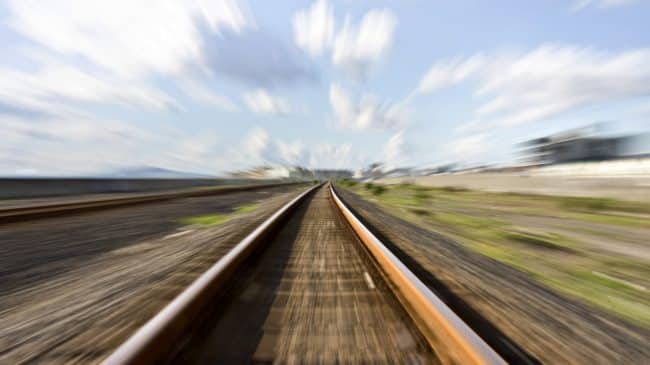California Gov. Gavin Newsom is dramatically scaling back the state’s high-speed rail project, at least for now. The decision is a victory for fiscal responsibility and commonsense transportation policy that should give pause to those advocating high-speed rail as part of a Green New Deal.
What remains in Gov. Newsom’s scaled back project still raises concerns that may dictate further policy changes. In his Feb. 12 State of the State message, Newsom announced his intention to truncate the high-speed rail line south of Bakersfield and west of Merced. He said he is indefinitely postponing the most expensive aspects of the project: tunnels under the Pacheco Pass and Tehachapi Mountains, which would have connected the Bay Area and Los Angeles Basin respectively.
So a project originally intended to connect Sacramento, San Francisco, San Jose, Los Angeles, Anaheim, and San Diego is now greatly reduced in scope and cost. Unfortunately, the downsizing leaves San Francisco with an overbuilt Transbay Transit Center, a $2.2 billion structure intended to be the high-speed rail system’s northern terminus. Also orphaned is the $188 million Anaheim Regional Intermodal Transportation Center in Orange County. These two facilities are now relegated to primarily being enormous bus stations.
Gov. Newsom bowed to fiscal realities that his predecessor had avoided: the state could not realistically expect to raise the money needed to build the train system. In 2008, voters were told to expect a $35 billion system funded by a combination of state bond proceeds, federal grants and private investment. But costs quickly mounted and private investment never materialized.
The decision to route the train through the Central Valley decreased ridership and increased costs. Potential investors likely came to similar conclusions to Reason Foundation, when we reported that high-speed rail ridership, and thus revenues, would come in far below state projections. Meanwhile, federal grant funding dried up after Democrats lost control of the House of Representatives in 2010 and the Senate in 2014.
Although Democrats now control the House again and may sweep back into power in 2020, renewed funding for California high-speed rail is unlikely. The project has already received a critical audit from the state auditor and will likely face negative findings when the Federal Railroad Administration publishes its own audit in the coming months. Having proved itself a poor steward of public funds, the California High-Speed Rail Authority may not be well-positioned to receive new funding, whichever party is in charge.
Failure of the bullet train in California should give pause to Green New Deal advocates, some of whom hope to replace large amounts of air travel with a national network of high-speed rail lines. The Green New Deal is framed as a response to a climate change emergency requiring a rapid response — starting with drastic reductions in greenhouse gas emissions by 2030. But the California experience shows that high-speed rail in the US takes a long time to plan and execute. The California High-Speed Rail Authority was formed in 1996, got funding in 2008, but wasn’t planning to begin operating the full-service system (running between Los Angeles and San Francisco) until 2033.
The operating segment that Gov. Newsom says is going to continue would connect Bakersfield, Hanford, Fresno, Madera and Merced — covering a total distance of about 165 miles in the Central Valley. Realistically, no fiscally prudent government entity or private developer would plan a high-speed rail line to serve such a short, low-density, low-population corridor.
The region is already served by Amtrak’s San Joaquins train, which has seven daily departures. The existing Amtrak service is relatively slow, at just over three hours, so a new train could provide faster connections between these cities. But the benefits will be limited. Although high-speed rail has a theoretical maximum speed of 220 miles per hour, average speeds are much slower given time spent in stations, accelerating and decelerating. End to end travel time for Central Valley High-Speed Rail could be in the range of 90 minutes.
Cities at the northern end of the operating segment have relatively low populations, so the most common trip along the route will be between Fresno and Bakersfield, covering a distance of about 110 miles. The current two-hour trip between these cities would likely be reduced to about one hour.
Set against these modest benefits are the costs of building the high-speed rail project. This not only involves several billion dollars of expenditures but also the disruptions arising from land acquisition and construction. Because high-speed rail lines have to be relatively straight —to limit curves that require reduced speeds— they cannot be laid along the existing right of way. As a result, the high-speed rail authority is acquiring large amounts of land, which is adversely impacting Central Valley farmers. In some places, the rail line is bisecting orchards and fields, making them unusable. The state is also resorting to eminent domain to take land that farmers would prefer to cultivate and hand down to their descendants. In urban areas, businesses are being obliged to relocate or close while motorists face frequent road closures.
Much of the line has been built so removing infrastructure already in place may not make sense. However, parts of the system that are not already under construction could be re-evaluated. Portions of the line could run on or parallel to existing San Joaquins track, reducing further cost and disruption.
Gov. Newsom has made a good decision and taken an important step toward financial reality. Unfortunately, the remaining segment also does not make sense in its current form. Hopefully, new state rail authority leadership and the Newsom can fine tune their plans to provide better passenger rail service in the Central Valley with minimal cost and disruption to taxpayers.


